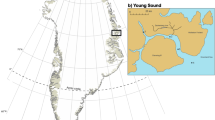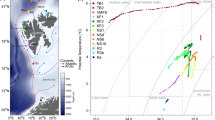Abstract
The population of small copepod species (approximately <1 mm) were investigated during an annual cycle in Disko Bay, western Greenland. The small species considered were Acartia longiremis, Pseudocalanus spp., Oithona spp., Oncaea spp., Microsetella spp., and Microcalanus spp. Most of the small species were present in the surface waters year round and numerically dominated the community, and in biomass from late summer and throughout winter. Oithona spp. was numerically the main contributor, while Pseudocalanus spp. dominated in terms of biomass. In the uppermost 50 m, maximum abundance, biomass and secondary production were observed in late September after the phytoplankton production practically had terminated and the winter initiated. The free spawning Acartia longiremis showed a strong seasonal fluctuation in biomass and egg production, in contrast to the egg carrying species Pseudocalanus spp. and Oithona spp. These had a long spawning season and maintained a more stable biomass year round. Secondary production was estimated by three different ways: (1) based on the obtained specific egg production rates, (2) a temperature dependent equation, and (3) a multilinear regression taking temperature, body weight and chlorophyll into consideration. The contribution of the small species was insignificant when compared to the large Calanus species during the spring- and post-bloom. However, during late summer and winter, where Calanus had left the upper water strata for hibernation, the small species played a crucial role in the pelagic carbon cycling.







Similar content being viewed by others
References
Banse K (1982) Mass-scaled rates of respiration and intrinsic growth in very small invertebrates. Mar Ecol Prog Ser 9:281–297
Berggreen U, Hansen B, Kiørboe T (1988) Food size spectra, ingestion and growth of the copepod Acartia tonsa during development: implications for determination of copepod production. Mar Biol 99:341–352
Buch E (1990) A monograph on the physical environment of Greenland water. Greenland Fisheries Research Institute, Copenhagen
Bunker AJ, Hirst AG (2004) Fecundity of marine planktonic copepods: global rates and patterns in relation to chlorophyll a, temperature and body weight. Mar Ecol Prog Ser 279:161–181
Calbet A, Trepat I, Aril L (2000) Naupliar growth versus egg production in the calanoid copepod Centropages typicus. J Plankton Res 22:1393–1402
Conover RJ, Huntley M (1991) Copepods in ice-covered sea—distribution, adaptations to seasonally limited food, metabolism, growth patterns and life cycle strategies in polar seas. J Mar Syst 2:1–41
Conover RJ, Siferd TD (1993) Dark-season survival strategies of coastal zone zooplankton in the canadian arctic. Arctic 46(4):303–311
Conover RJ, Herman AW, Prinsenberg SJ, Harris LR (1986) Distribution of and feeding by the copepod Pseudocalanus under fast ice during the Arctic spring. Science 232(4755):1245–1247
Corkett CJ, McLaren IA (1978) The biology of Pseudocalanus. Adv Mar Biol 15:1–231
Dam HG, Peterson WT, Bellatoni DC (1994) Seasonal feeding and fecundity of the calanoid Acartia tonsa in Long Island Sound: is omnivory important to egg production? Hydrobiologia 292/293:191–199
Davis CC (1976) Overwintering strategies of common planktonic copepods in some North Norway fjords and sounds. Astarte 9:37–42
Elgmork K (1980) Evolutionary aspects of diapause in freshwater copepods. In: Kerfoot WC (ed) Evolution and ecology of zoopolankton communities. Am Soc Limnol Oceangr Spec Symp 3 The University press of New England, Hanover, NH, pp 411–417
Fenchel T (1974) Intrinsic rate of natural increase: the relationship with body size. Oceanologia 14:317–326
Fortier M, Fortier L, Hattori H, Saito H, Legendre L (2001) Visual predators and the diel vertical migration of copepods under Arctic sea ice during the midnight sun. J Plankton Res 23:1263–1278
Green EP, Dagg MJ (1997) Mesozooplankton associations with medium to large marine snow aggregates in the northern Gulf of Mexico. J Plankton Res 19(4):435–447
Hansen AS, Nielsen TG, Levinsen H, Madsen SD, Thingstad FT, Hansen BW (2003) Impact of changing ice cover on pelagic productivity and food web structure in Disko Bay, West Greenland: a dynamic model approach. Deep Sea Res I 50:171–187
Hansen PJ, Bjørnsen PK, Hansen BW (1997) Zooplankton grazing and growth: scaling within the 2–2,000-μm body size range. Limnol Oceangr 42:687–704
Hansen BW, Nielsen TG, Levinsen H (1999) Plankton community structure and carbon cycling on the western coast of Greenland during the stratified situation. III. Mesozooplankton. Aquat Microb Ecol 16:233–249
Hirche H-J, Mumm N (1992) Distribution of dominant copepods in the Nansen Basin, Arctic Ocean, in summer. Deep Sea Res 39(Suppl 2):485–505
Hirst AG, Bunker AJ (2003) Growth of marine planktonic copepods: global rates and patterns in relation to chlorophyll a, temperature, and body weight. Limnol Oceanogr 48:1988–2010
Hirst AG, Lampitt RS (1998) Towards a global model of in situ weight-specific growth in marine planktonic copepods. Mar Biol 132:247–257
Hirst AG, McKinnon AD (2001) Does egg production represent adult female copepod growth? A call to account for body weight changes. Mar Ecol Prog Ser 223:179–199
Hopcroft RR, Clarke C, Nelson RJ, Raskoff KA (2005) Zooplankton communities of the Arctic Canada Basin: the contribution by smaller taxa. Polar Biol 28:198–206
Huntley ME, Lopez MDG (1992) Temperature-dependent production of marine copepods: a global synthesis. Am Nat 140:201–242
Jacobsen HH, Halvorsen E, Hansen BW, Wisser AW (2005) Effects of prey mobility and concentration on feeding in Acartia tonsa and Temora longicornis: the importance of feeding modes. J Plankton Res 27:775–785
Jespersen P (1934) Copepoda. The Godthaab expedition 1928. Medd Grønl 79(19):1–166
Jonasdottir SH (1989) Effects of food concentration on egg-production rates of two species of Pseudocalanus: laboratory observations. J Exp Mar Biol Ecol 130:33–43
Kiørboe T, Nielsen TG (1994) Regulation of zooplankton biomass and production in a temperate, coastal ecosystem. I. Copepods. Limnol Oceanogr 39:493–507
Kiørboe T, Sabatini M (1994) Reproductive and life cycle strategies in egg-carrying cyclopoid and free-spawning calanoid copepods. J Plankton Res 16:1353–1366
Kiørboe T, Sabatini M (1995) Scaling of fecundity, growth and development in marine planktonic copepods. Mar Ecol Prog Ser 120:285–298
Kiørboe T, Møhlenberg F, Hamburger K (1985) Bioenergetics of the planktonic copepod Acartia tonsa: relation between feeding, egg production and respiration, and composition of specific dynamic action. Mar Ecol Prog Ser 26:85–97
Klein Breteler WCM, Fransz HG, Gonzalez SR (1982) Growth and development of four calanoid copepod species under experimental and natural conditions. Neth J Sea Res 16:195–207
Koski M, Kiørboe T, Takahashi K (2005) Benthic life in the pelagic: aggregate encounter and degradation rates by pelagic harpacticoid copepods. Limnol Oceanogr 50:1254–1263
Krause M, Trahms J (1983) Zooplankton dynamics during FLEX 76. In: Sundermann J, Lenz W (eds) North Sea dynamics. Springer, Berllin, pp 632–661
Levinsen H, Nielsen TG, Hansen BW (2000) The annual succession of marine pelagic protozoans in Disko Bay, West Greenland, with emphasis on winter dynamics. Mar Ecol Prog Ser 206:119–134
Lindley JA (1990) Distribution of overwintering calanoid copepod eggs in sea-bed sediments around southern Britain. Mar Biol 104:209–217
Madsen SD, Nielsen TG, Hansen BW (2001) Annual population development and production by Calanus fimarchicus, C. glacialis and C. hyperboreus in Disko Bay, western Greenland. Mar Biol 139(1):75–83
Marshall SM (1949) On the biology of the small copepods in Loch Striven. J Mar Biol Assoc UK 28:45–122
McLaren IA (1969) Population and production ecology of zooplankton in Ogac Lake, a landlocked fjord on Baffin Island. J Fish Res Board Can 26:1485–1559
McLaren IA, Sévigny JM, Corkett CJ (1989) Temperature-dependent development in Pseudocalanus species. Can J Zool 67:559–564
Munk P, Hansen BW, Nielsen TG, Thomsen HA (2003) Changes in plankton and fish larvae communities across hydrographic fronts off west Greenland. J Plankton Res 25:815–830
Niehoff B, Madsen SD, Hansen BW, Nielsen TG (2002) Reproductive cycles of three dominant Calanus species in Disko Bay, West Greenland. Mar Biol 140:567–576
Nielsen TG, Andersen CM (2002) Plankton community structure and production along a freshwater influenced Norwegian fjord system. Mar Biol 141(4):707–724
Nielsen TG, Sabatini M (1996) Role of cyclopoid copepods Oithona spp. in North Sea plankton communities. Mar Ecol Prog Ser 139:79–93
Nielsen TG, Møller EF, Satapoomin S, Ringuette M, Hopcroft RR (2002) Egg hatching rate of the cyclopoid copepod Oithona similis in arctic and temperate waters. Mar Ecol Prog Ser 236:301–306
Norrbin FM (1994) Seasonal patterns in gonad maturation, sex ratio and size in some small high latitude copepods: implications for overwintering tactics. J Plankton Res 16:115–131
Norrbin FM (1996) Timing of diapause in relation to the onset of winter in the high-latitude copepods Pseudocalanus acuspes and Acartia longiremis. Mar Ecol Prog Ser 142:99–109
Norrbin MF, Olsen RE, Tande KS (1990) Seasonal variation in lipid class and fatty acid composition of two small copepods in Balsfjorden, northern Norway. Mar Biol 105:205–211
Naess T, Nilssen JP (1991) Diapausing fertilized adults—a new pattern of copepod life-cycle. Oecologia 86:368–371
Paffenhöfer G-A (1993) On the ecology of marine cyclopoid copepods (Crustacea. Copepoda). J Plankton Res 15:37–55
Paffenhöfer G-A, Harris RP (1976) Feeding, growth and reproduction of the marine planktonic copepod Pseudocalanus elongatus Boeck. J Mar Biol Assoc UK 56:327–344
Paffenhöfer G-A, Mazzocchi MG (2003) Vertical distribution of subtropical epiplanktonic copepods. J Plankton Res 25:1139–1156
Poulet SA (1978) Comparison between five coexisting species of marine copepods feeding on natural occurring particulate matter. Limnol Oceanogr 23(6):1126–1143
Rysgaard S, Nielsen TG, Hansen BW (1999) Seasonal variation in nutrients, pelagic primary production and grazing in a high-arctic coastal marine ecosystem, Young Sound, Northeast Greenland. Mar Ecol Prog Ser 179:13–25
Sabatini M, Kiørboe T (1994) Egg production, growth and development of cyclopoid copepod Oithona similis. J Plankton Res 16:1329–1351
Satapoomin S (1999) Carbon content of some common tropical Andaman Sea copepods. J Plankton Res 21:2117–2123
Smidt ELB (1979) Annual cycles of primary production and of zooplankton at Southwest Greenland. Medd Grønl Biosci 1:1–52
Thompson BM (1982) Growth and development of Pseudocalanus elongatus and Calanus sp. in the laboratory. J Mar Biol Ass UK 62:359–372
Thor P, Nielsen TG, Tiselius P, Juul-Pedersen T, Michel C, Møller EF, Dahl K, Selander E, Gooding S (2005) Post-spring bloom community structure of pelagic copepods in the Disko Bay, Western Greenland. J Plankton Res 27:341–356
Ussing HH (1938) The Biology of some important plankton animals in the fjord of east Greenland. Medd Grønl 100(7):1–108
Uye S (1985) Resting egg production as a life history strategy of marine planktonic copepods. Bull Mar Sci 37:440–449
Vidal J (1980) Physioecology of zooplankton. I. Effects of Phytoplankton concentration, temperature, and body size on the growth rate of Calanus pacificus and Pseudocalanus sp. Mar Biol 56:111–134
Ward P, Hirst AG (2007) Oithona similis in a high latitude ecosystem: abundance, distribution and temperature limitation of fecundity rates in a sac spawning copepod. Mar Biol 151:1099–1110
Wiborg KF (1955) Zooplankton in relation to hydrography in the Norwegian Sea. Fisk Dir Skr 11:1–166
Acknowledgments
We are greatly indebted to skipper Jørgen Broberg and the rest of the crew of R.V. “Porsild” for the help and support on the many cruises and to the hunters operating the dog sledges and helping on the sea ice. The board of the Arctic Station, University of Copenhagen, is acknowledged for providing the vessel and laboratory facilities. Many thanks are due to the late technical manager of the Arctic Station, Leif Skytte. Thanks also to Birgit Søborg and Dr. Thomas Wernberg Møller for their technical assistance and to Dr. Peter Thor, Dr. Anne Winding and several unknown reviewers for comments to improve the manuscript. This study was supported by the Danish National Research Council, Proj. No. 9501038 to TGN and BWH.
Author information
Authors and Affiliations
Corresponding author
Additional information
Communicated by M. Kühl.
Rights and permissions
About this article
Cite this article
Madsen, S.D., Nielsen, T.G. & Hansen, B.W. Annual population development and production by small copepods in Disko Bay, western Greenland. Mar Biol 155, 63–77 (2008). https://doi.org/10.1007/s00227-008-1007-y
Received:
Accepted:
Published:
Issue Date:
DOI: https://doi.org/10.1007/s00227-008-1007-y




